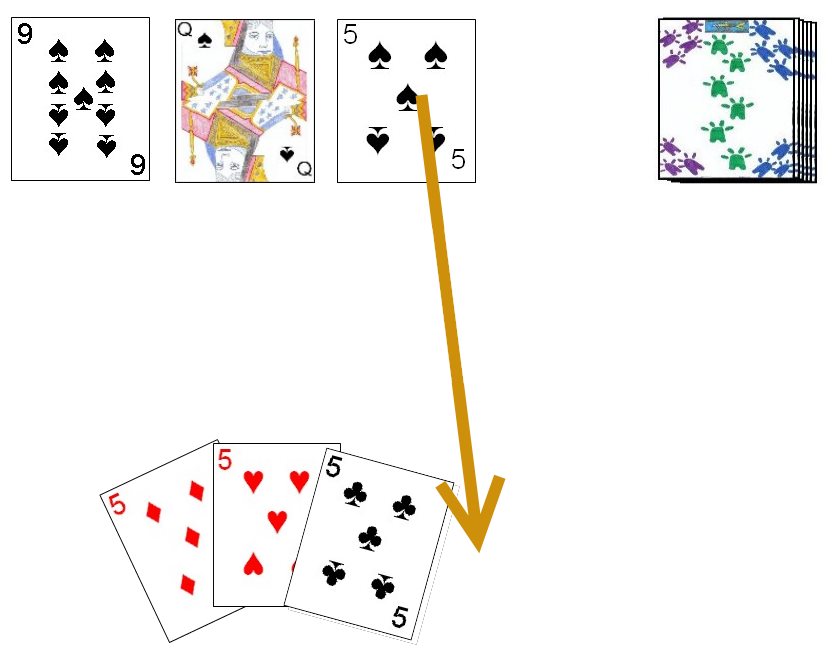 Pounce Commerce
Pounce Commerce: Pounce Commerce was once the most popular version of Commerce played. It is very similar to the standard game with one key difference.
If a player currently has a Tricon in hand and the fourth card of that same denomination appears on the table (whether discard in an exchange by another player or added from the stock pile after a round), the player having the Tricon of the same denomination players may shout Pounce and immediately take the card into his hand. He may do this even if not currently his turn, simply taking the card and adding it to his current hand. This gives him a four card hand, which is considered higher than any three card hand. The only hand considered higher would be another four card hand of a higher
denomination that another player might obtain by also Pouncing. Immediately after the player calls Pounce and takes the card, another card is added from the stock pile to the center of the pile, and the game resumes as before the player called Pounce.
No Pair or Point: In some of the earliest versions of the game, the Pair and Point categories are not used. As such, only the categories Tricon, Sequence and Flush are recognized in the game. If a player does not have a hand which fulfills that category, they can never win the hand.
Trade and Barter: Trade and Barter is a variation of Commerce which hails from England. This variant has several differences from the standard game, as follows:
- No widow hand is added to the center of the table. The remainder of the pack is simply set face-down in the center of the table.
- The only combinations recognized in this version are the categories of Tricon, Sequence and Point.
- Each player on his turn (starting with the player to the dealers immediate left) may take one of three actions on his turn:
- Trade
: If the player opts to make a trade, he states "Trade" and passes one card face down to the dealer. The dealer places that player's card face-down at the bottom of the stock, and replaces this card with the top card from the stock, passing it face-down to that player.
- Barter
: If a player opts to barter, he states "Barter" and passes any card of his choice face-down to the player to his immediate
left. This player also selects any card of his choice in replacement, passing that card, also face-down to the bartering player.
- Knock
: If a player has a Tricon, Sequence or Point in hand and is satisfied with his current hand, he may knock. After that player knocks, the hand immediately ends and the players compare hands to determine who is the winner of the hand.
- The normal ranking of the card combinations as per the standard game is used for ranking of a Tricon or Sequence. However, the Point category is slightly different. In this variant, for comparison of multiple hands in the Point category, that hand has a value equal to the sum of cards of the same suit in the players hand (minimum of two). For this summation, the value of the cards is the same as in the parent game; Aces 11 each, Court cards 10 each, and all other cards the value marked on the face of the card. If two or more players have the same point value, the higher is determined to be that which consists of more cards. If the hands are also tied in the number of cards of the same suit, the player nearest in normal rotation, to the dealer is considered the higher.
Paiute: Paiute is a Hawaiian game in which players draw and discard in an attempt to be the first player to form their hand into the highest legal combination.
Paiute is designed for play by 2 to 5 players using one standard 52 card deck. The ranking of the cards in this deck as follows (from highest to lowest): Ace, King Queen, Jack, 10, 9, 8, 7, 6, 5, 4, 3, 2. For purposes of Straight Flush combinations, an Ace can be considered high (above the King), or low (before the two).
Determination of the first dealer and seating positions can be determined using a variety of methods, with the most common method being a cut for high card. Using this method, each player would randomly cut a card from the shuffled deck. If two or more players cut a card of the same
denomination as that already cut by another player, they would cut a new card, continuing until cutting a card not previously cut by any other player. The players would then take seats at the table in order of preference from highest card cut to lowest. The player cutting the highest ranked card would also be set as the first dealer, and after each hand the role of dealer rotates to the next player in a clockwise direction.
The designated dealer then thoroughly shuffles the deck and offers it to the player at his right to cut. After the cut, he then begins dealing the cards in a clockwise direction around the table, starting with the player at his left. He deals the cards one-at-a-time and face-down continuing until each player has a total of five cards. After each player has the requisite five cards, he then deals the next card face-up to the center of the table, and places the remainder of the deck partially covering the dealt card, as the stock. All cards of the same rank as the dealt face-up card are considered wild cards during the hand and can thus be used to replace any other card in the deck in forming combinations. After the stock has been set, the dealer then removes the top card from the face-down stock pile, placing that card face-up beside the stock, to start the discard pile.
The turns rotate in a clockwise direction around the table, with the player to the immediate left of the dealer having the first turn. Each turn begins with a player first drawing a card. The player may either draw the top, face-down card from the stock pile or the top face-up card in the discard pile.
After drawing a card, the player may, if he has a valid combination elect to Call. In order to so Call, the player must have one of the valid winning combinations in the game. A player is never obligated to Call if having such a combination, and may continue normal play, without calling, in an attempt to get a higher ranked combination. The following are the valid combinations in this game, shown from lowest ranked combination to highest:
| Valid Combination | Description/Notes | Example |
|---|
| Two/Two/Two (Paiute) | This combination consists of three
individual pairs of cards. This combination can only be called after a player's first turn of the hand. After each player has had their first turn, this is no longer considered a legal combination. If multiple players have such a combination, these combinations can be ranked by first comparing the highest pair, and if these are of equal rank, comparing the second highest rank, and if these are also of equal rank, then comparing the lowest pair. |  |
| Three/Three | This combination consists of two sets of three cards of the same rank. If comparing multiple such combinations, the highest ranking three of a kind of each player is compared to determine which is higher. If these are of the same rank, the lower three of a kind if compared amongst these players. |  |
| Four/Two | This combination consists of four cards, all of the same rank, combined with a pair of two cards of the same rank. In comparing two such combinations, the highest is that which consists of the highest four of a kind. |  |
| Straight Flush | This combination consists of five cards in direct sequential order, all of the same suit. In comparing multiple Straight Flush combinations, the straight flush consisting of the highest top card is considered the higher. |  |
| Royal Flush | This combination consists of an Ace, King, Queen, Jack, and 10 all in the same suit. |  |
| Five of a Kind | This combination consists of five cards all of the same suit. As there are only four of every natural ranked card in the deck, this
combination will, by necessity, contain at least one wild card. If multiple players have this combination, the highest would be that in which the five cards are of the highest ranked cards. |  |
These are the only combinations that are recognized in the game. A player that calls, then immediately places his hand face-up on the table. If the combination contains six cards, the player does not need to discard, however if the combination is one of the five card combinations, the player must discard one card to the top of the discard pile.
If the dealer was the player that called, the game immediately ends and the dealer wins the hand. However, if it was a player other than the dealer whom called, each other remaining player, in a clockwise direction up to the dealer has one more turn to attempt to improve their hand. If a player, on that last turn has a higher or equally ranked combination as the highest combination played to the table can also Call, placing their hand face-up on the table for comparison. The last player to call with the highest ranked hand is the winner of that hand. If the highest ranked hand is tied by one or more other such hands, these players tie as the winners of that hand.
If a player does not Call on his turn, he then discards one card from his hand, face-up, to the top of the discard pile. If the player drew the top card from the discard pile, he may never discard this same card back onto the discard pile.
As mentioned above, the game continues until one or more player Calls, with the highest Call winning the hand. If the stock pile runs out before any player calls, all cards under the top card of the discard pile are gathered up, shuffled and turned over to start a new stock pile.
Copyright © 2015 CatsAtCards.com. All rights reserved.
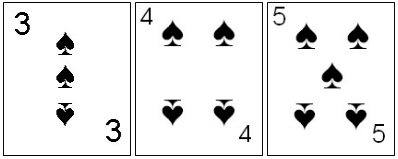
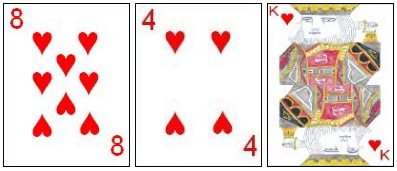
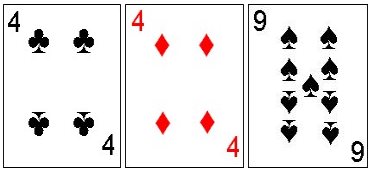
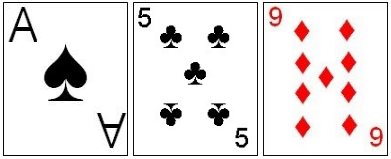
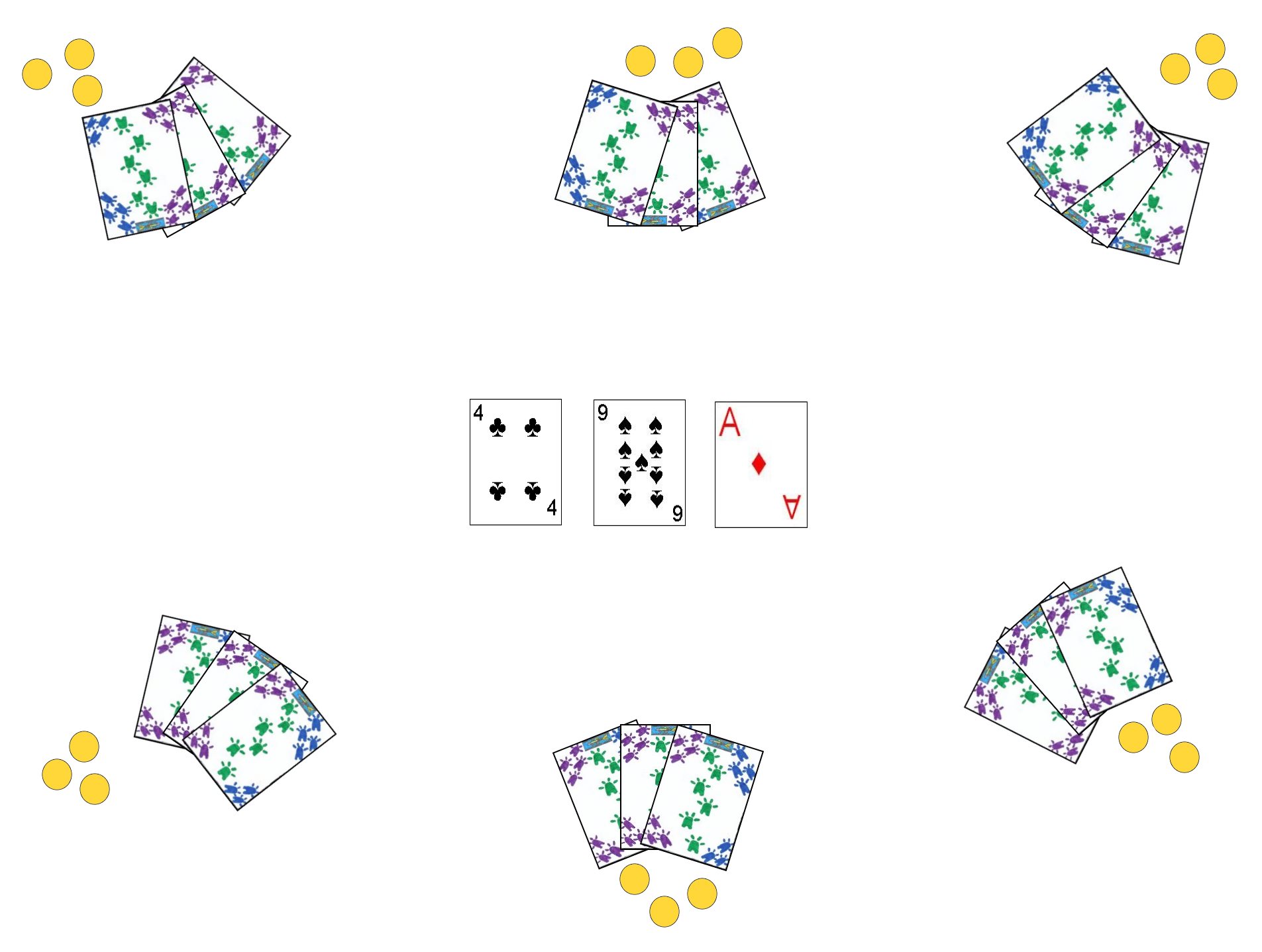 Before the game begins, each player should be provided three tokens which he places on the table in front of himself. Determination of the first dealer and seating positions can be performed in a variety of methods, with drawing for high cards a common method. The player would each draw a card from the face-down shuffled deck and take seats at the table in the order of ranking of cards drawn. The player drawing the highest card of all would be set as the first dealer, and thereafter the deal passes in a clockwise rotation around the table. If two or more players draw cards of the same denomination, those players should draw again, continuing to draw until they draw a card which is of a unique denomination to all other cards drawn.
Before the game begins, each player should be provided three tokens which he places on the table in front of himself. Determination of the first dealer and seating positions can be performed in a variety of methods, with drawing for high cards a common method. The player would each draw a card from the face-down shuffled deck and take seats at the table in the order of ranking of cards drawn. The player drawing the highest card of all would be set as the first dealer, and thereafter the deal passes in a clockwise rotation around the table. If two or more players draw cards of the same denomination, those players should draw again, continuing to draw until they draw a card which is of a unique denomination to all other cards drawn.




 Pounce Commerce: Pounce Commerce was once the most popular version of Commerce played. It is very similar to the standard game with one key difference.
Pounce Commerce: Pounce Commerce was once the most popular version of Commerce played. It is very similar to the standard game with one key difference.





